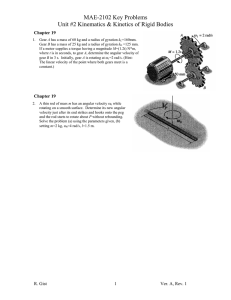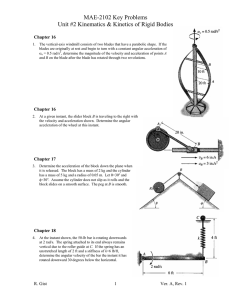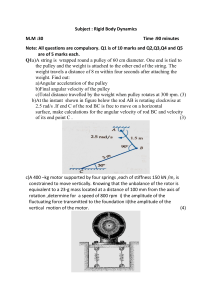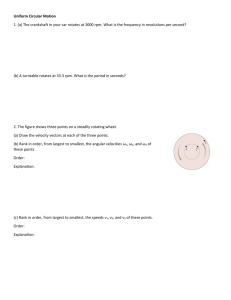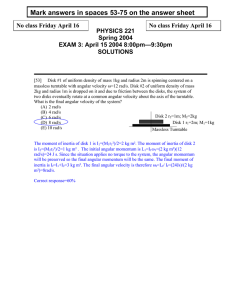EME 232 Engineering Dynamics Spring 2008
advertisement
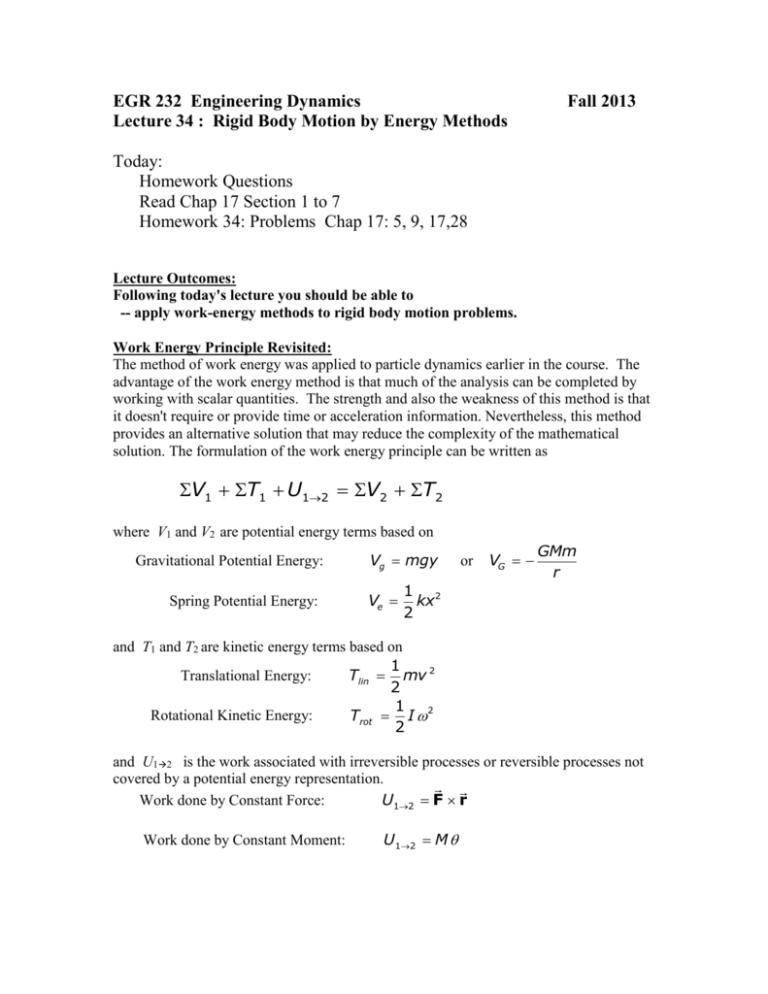
EGR 232 Engineering Dynamics Lecture 34 : Rigid Body Motion by Energy Methods Fall 2013 Today: Homework Questions Read Chap 17 Section 1 to 7 Homework 34: Problems Chap 17: 5, 9, 17,28 Lecture Outcomes: Following today's lecture you should be able to -- apply work-energy methods to rigid body motion problems. Work Energy Principle Revisited: The method of work energy was applied to particle dynamics earlier in the course. The advantage of the work energy method is that much of the analysis can be completed by working with scalar quantities. The strength and also the weakness of this method is that it doesn't require or provide time or acceleration information. Nevertheless, this method provides an alternative solution that may reduce the complexity of the mathematical solution. The formulation of the work energy principle can be written as V1 T1 U12 V2 T2 where V1 and V2 are potential energy terms based on Gravitational Potential Energy: Spring Potential Energy: Vg mgy Ve or VG GMm r 1 2 kx 2 and T1 and T2 are kinetic energy terms based on 1 Translational Energy: Tlin mv 2 2 1 Rotational Kinetic Energy: Trot I 2 2 and U12 is the work associated with irreversible processes or reversible processes not covered by a potential energy representation. Work done by Constant Force: U12 F r Work done by Constant Moment: U 1 2 M Problem 1: For a bowling ball released from rest. Ball diameter is 10 inches. Ball weight is 16 lb. 5 ft 20o a) find the velocity at the bottom of the ramp, assuming that it does not slide during the motion. b) does a 10 lb ball get to the bottom faster or slower than the 16 lb ball. ------------------------------------------------------------------------------------------------------- Problem 2: A yo-yo of weight 0.3 lb and a radius of gyration of 0.06 ft is released from rest. The shaft radius is 0.02 ft. Find the angular velocity after it descends 3 ft. Problem 3: Two 8 lb links connect two 10 lb disks as shown. The entire structure is released from rest at θ = 60 degrees. Find the angular velocity of the disks when θ is equal to 0. B 3 ft 3 ft θ = 60o A C Problem 4: A 20 lb disk and a 5 lb link are released from rest in the horizontal position (θ = 0). The disk rolls without slipping along the circular contact surface. Determine the angular velocity of the disk when θ = 45 degrees. B A θ 0.5 ft 2 ft EGR232 Dynamics: Homework Set 34 Fall 2013 Problem 17.5 The flywheel of a punching machine has a mass of 300 kg and a radius of gyration of 600 mm. Each punching operation requires 2500 J of work. a) Knowing that the speed of the flywheel is 300 rpm just before a punching, determine the speed immediately after the punching. b) If a constant 25 N-m couple is applied to the shaft of the flywheel determine the number of revolutions executed before the speed is again 300 rpm. -------------------------------------------------------------------------------------------------------- EGR232 Dynamics: Homework Set 34 Fall 2013 Problem 17.9 Each of the gears A and B has a mass of 2.4 kg and a radius of gyration of 60 mm, while gear C has a mass of 12 kg and a radius of gyration of 150 mm. A couple M of constant magnitude 10 N-m is applied to gear C. Determine a) the number of revolutions of gear C required for its angular velocity to increase from 100 to 450 rpm, b) the corresponding tangential force acting on gear A. -------------------------------------------------------------------------------------------------------- EGR232 Dynamics: Homework Set 34 Fall 2013 Problem 17.17 A slender 4 kg rod can rotate in a vertical plane about a pivot at B. A spring of constant k = 400 N/m and of unstretched length 150 mm is attached to the rod as shown. Knowing that the rod is released from rest in the position shown, determine its angular velocity after it has rotated through 90 degrees. -------------------------------------------------------------------------------------------------------- EGR232 Dynamics: Homework Set 34 Fall 2013 Problem 17.28 A collar B, of mass m and negligible dimensions, is attached to the rim of a hoop of the same mass m and of radius r that rolls without sliding on a horizontal surface. Determine the angular velocity ω1 of the hoop in terms of g and r when B is directly above the center A, knowing that the angular velocity of the hoop is 4ω1 when B is directly below A. ----------------------------------------------------------------------------------------------------------Solution:
